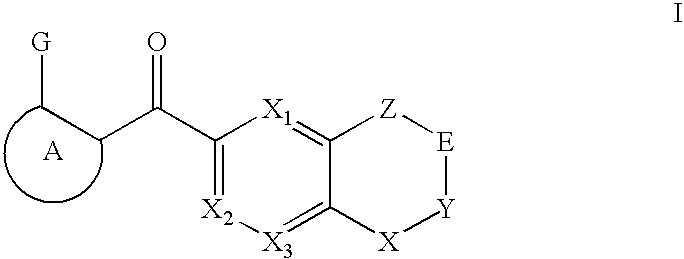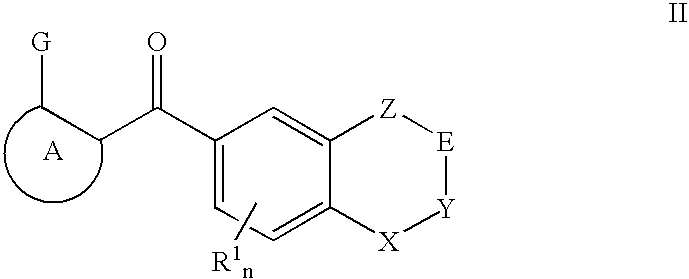Raf Modulators and Methods of Use
- Summary
- Abstract
- Description
- Claims
- Application Information
AI Technical Summary
Benefits of technology
Problems solved by technology
Method used
Image
Examples
example 1
[0251] 6-{2-[(4-Chlorophenyl)methyl]-1-hydroxy-3-oxo-2,3-dihydro-1H-isoindol-1-yl}-2H-1,4-benzoxazin-3(4H)-one: To a solution of 2-[(3-oxo-3,4-dihydro-2H-1,4-benzoxazine-6-yl)carbonylbenzoic acid (50 mg, 0.17 mmol) in N,N-dimethylformamide (1.00 mL) was added N-methylmorpholine (74 uL, 0.67 mmol) followed by addition of HOAt (55 mg, 0.40 mmol) and HATU (130 mg, 0.34 mmol). The mixture was stirred for 30 minutes at room temperature followed by the addition of 4-chloro-benzylamine (49 uL, 0.40 mmol). The reaction mixture was then heated to 60° C. for 2 h. The mixture was cooled to room temperature and the solvent was evaporated. The residue was dissolved in ethyl acetate and the organic layer was washed with brine, 1.0 M aq. hydrochloric acid, brine, saturated aq. sodium-hydrogencarbonate and brine. The organic layer was separated, dried over anhydrous sodium sulfate, filtered and the filtrate concentrated in vacuo. The residue was recrystallized from methanol to afford the title comp...
example 2
[0323] Methyl {5-[1-hydroxy-3-oxo-2-(phenylmethyl)-2,3-dihydro-1H-isoindol-1-yl]-1H-benzimidazol-2-yl}carbamate: A solution of 2-(4-chloro-3-nitrobenzoyl)benzoic acid (5.0 g, 16.36 mmol) was heated to reflux in 28-30% aq. ammonium hydroxide (100 mL) for 18 h. The solution was cooled to room temperature followed by addition of 6N aq. hydrochloric acid until pH to 7. The precipitated yellow solid was collected by filtration and washed with water then dried in vacuo to provide 2-[(4-amino-3-nitrophenyl)carbonyl]benzoic acid (4.60 g, 98%). MS (EI) for C14H10N2O5: 288 (MH+).
[0324] A solution of 2-[(4-amino-3-nitrophenyl)carbonyl]benzoic acid (4.60 g, 16.00 mmol) in methanol (300 mL) in the presence of catalytic amount of cc. sulfuric acid was heated to reflux for 18 h. The solution was cooled to room temperature and the solvent was evaporated. The yellow precipitate formed was collected by filtration, washed with water and dried in vacuo to provide methyl 2-[(4-amino-3-nitrophenyl)carbo...
example 3
[0332] 3-Hydroxy-3-[2-(methylamino)-1H-benzimidazol-5-yl]-2-(phenylmethyl)-2,3-dihydro-1H-isoindol-1-one: A solution of 2-(4-chloro-3-nitrobenzoyl)benzoic acid (38.5 g, 0.126 mol) in ammonium hydroxide (33% wt, 200 mL) was heated to a gentle reflux and stirred for 24 h. An additional ammonium hydroxide (200 mL) was added every 5 h within the 24 h reaction time period. The reaction mixture was cooled to room temperature and was added 6N aqueous hydrochloric acid until pH reached 2. The precipitated yellow solid was collected by filtration and washed with water then dried in vacuo to provide 2-[(4-amino-3-nitrophenyl)carbonyl]benzoic acid (38.8 g, 95%). 1H NMR (400 MHz, CD3OD): 8.27 (d, 1H), 8.11 (d, 1H), 7.80 (dd, 1H), 7.72 (td, 1H), 7.65 (td, 1H), 7.39 (d, 1H), 7.01 (d, 1H); MS (EI) for C14H10N2O5: 309 (MNa+).
[0333] To a solution of 2-[(4-amino-3-nitrophenyl)carbonyl]benzoic acid (9.3 g, 32.4 mmol), HOAt (0.5 M in DMF, 97 mL, 48.7 mmol), N-methylmorpholine (14 mL, 129 mmol) and HAT...
PUM
| Property | Measurement | Unit |
|---|---|---|
| Volume | aaaaa | aaaaa |
| Cell death | aaaaa | aaaaa |
| Pharmaceutically acceptable | aaaaa | aaaaa |
Abstract
Description
Claims
Application Information
 Login to View More
Login to View More - R&D
- Intellectual Property
- Life Sciences
- Materials
- Tech Scout
- Unparalleled Data Quality
- Higher Quality Content
- 60% Fewer Hallucinations
Browse by: Latest US Patents, China's latest patents, Technical Efficacy Thesaurus, Application Domain, Technology Topic, Popular Technical Reports.
© 2025 PatSnap. All rights reserved.Legal|Privacy policy|Modern Slavery Act Transparency Statement|Sitemap|About US| Contact US: help@patsnap.com



